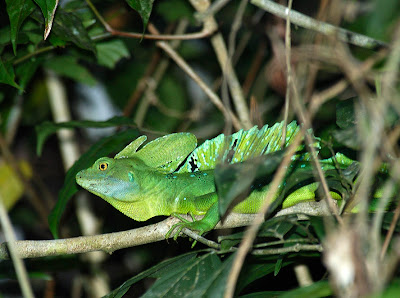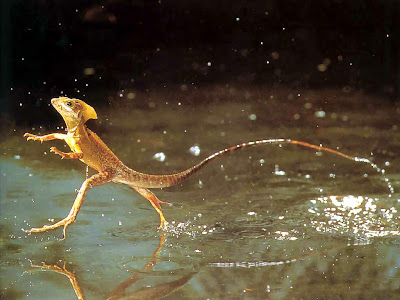The interpretation of Jesus Christ's ability to walk on water is generally left to biblical scholars, but modern day scientists have now been able to find out how the aptly named ‘Jesus lizard’ is able achieve a similar ‘miracle’ without falling in.
 |
| Jesus |
However, being cold blooded creatures, they need to bask in the sun to warm up their bodies to an effective working temperature but this can leave them vulnerable to being caught by predators – in particular birds of prey and small jungle cats.
In order to evade such predators the lizards have evolved an extraordinary escape mechanism. When frightened, the lizard will drop into the water and run across the surface which is how they have earned themselves the common name of ‘Jesus’ or ‘Jesus Christ’ lizard.
Basilisk lizards range in size from a weight of less than 2 grams right up to 200 grams, yet throughout their size range they are able to run across water on their hind legs at about 5 feet per second for a distance of approximately 15 feet. However, after this point they tend to ‘run’ out of energy, sinking to all fours before having to swim.
 |
| The Jesus Christ lizard |
Exactly how they do this has been revealed by using specialist slow-motion footage taken at 2,000 frames per second. The resulting film has been used as part of the BBC Life series.
Most animals that attempt to walk or run across water immediately sink toward their supporting limb because water - unlike solid ground - offers little support or resistance. However, basilisk lizards produce massive sideways forces in their running stride, which also helps them to stay upright.
The stride is divided into three phases: the slap, the stroke, and the recovery. During the slap, the foot moves vertically downward. During the stroke it moves backward, and during the recovery the foot moves up and out of the water, returning to the start position of the next step.
 |
| The Jesus Christ lizard running on water |
Simon Blakeney, a producer on the series who helped direct and film the footage of these basilisk lizards had this to say on the matter:
‘...because they run so fast they create a bubble as their feet hit the water and then they push off from this bubble before it bursts. They can only run at that speed. If they were going any slower, for example, they wouldn't stay upright; they would slip into the water and would have to swim...’
For related articles click onto the following links:
THE JESUS CHRIST LIZARD
THE LEAF-TAILED GECKO







No comments:
Post a Comment